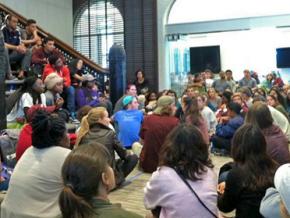Another Colgate is possible
At Colgate University, a sit-in and occupation by students forced the administration to take notice of racism and discrimination on campus.
MORE THAN 500 students took part in a 100-hour sit-in at Colgate University, occupying the lobby of the admissions building to demand changes in administration, curriculum and campus culture.
What began as a sit-in against racism on September 22 quickly developed into one against all forms of discrimination and marginalization, as students with different grievances made themselves heard as part of the movement.
A savvy online campaign made the protest go viral, with the hashtag #canyouhearusnow and its Twitter handle, @colgateacc, receiving more than 90,000 mentions within the first two days. National media from Inside Higher Ed and the Chronicle of Higher Education to MTV and ABC, covered the protest, and by the second day, messages of solidarity from other campuses including Bryn Mawr, Swarthmore and Columbia began pouring in.
A list of 21 demands, which ranged from changing the way campus tours are conducted to curricular reform to diversity training for staff and administrators, were presented to the administration. While hundreds occupied the building, the leaders of the movement fought a hard negotiating battle with top administrators, eventually returning with a document that was approved almost unanimously by the protesters on September 25.

Despite having won all their demands, the protesters decided to continue to occupy the building until the following morning, to ensure they had it in writing from the President of the university.
Colgate is an elite, mostly white campus, situated in the isolated village of Hamilton in upstate New York. The closest city is Syracuse, which is over an hour away. Campus life is dominated by the Greek system, with 20-odd Greek-letter organizations, many of which students claim are inhospitable to students of color and other minorities.
UNSURPRISINGLY, RACISM is not new to Colgate's campus. A sit-in in 2001 had put forward many of the same demands that were taken up this time around, and one common refrain you could hear is that nothing seems to have changed in 13 years. So why and how did this protest come about?
As students returned to campus this fall, the news of Mike Brown's murder and the protests in Ferguson were in the air. Four students decided to call for a solidarity demonstration. On August 28, a "Hands up, don't shoot!" demonstration brought out about 100 students and faculty. Following this, a faculty-led brown bag discussion on "Ferguson and the policing of Black bodies" drew a large audience. Shaped by the presence of a county sheriff as one of the key speakers, this discussion left many feeling like more needed to be done.
Calling themselves the Association of Critical Collegians--a reference to the Association of Black Collegians who had led an earlier sit-in--four student activists took the lead and in a matter of days mobilized 200 people for a meeting where they voted to begin a sit-in. The speed with which this sit-in came together speaks not only to the racial climate on campus but a sense of urgency and confidence, post-Ferguson, in speaking out against racism.
On the first day of the sit-in, students offered testimonies of racist and homophobic insults and abuses, of encounters with insensitive peers, administrators and staff, and even faculty, and of discriminatory treatment by campus police. The testimonies went on for seven hours, and there wasn't a dry eye in the room.
The picture that emerged was of a stifling campus atmosphere, with Black, LGBTQ and international students suffering daily humilities and indignities, often alone and in silence.
The sit-in broke through this silence, and many feel that an important result was not only the acceptance of the demands by administration but the emergence of a new activist solidarity and community among students, even faculty, who had been marginalized on a conservative campus for a long time.
This was a thoroughly multiracial movement: of the more than 500 students who participated, roughly half were white students, many of whom played leading roles, while the central leadership was made up of four women (one white and three women of color).
Monday morning came with 150 students marching across campus and occupying the lobby of the admissions building. When the president of the college and two senior deans arrived to speak to the students, they were asked to take a seat and listen to students' testimonies.
For seven hours (with a break for lunch), they listened. The emotional testimonies laid the groundwork for negotiations on the protesters' demands the following day.
Thanks in part to a racist backlash on the social media platform Yik Yak and Facebook the sit-in's numbers swelled over the next couple of days, as more than 500 students participated, and the campaign went viral. A letter of support signed by more than 150 faculty was circulated and forwarded to the administration.
Some professors held their classes at the sit-in, and others combined their classes for impromptu teach-ins on racism. After hours of negotiations over the demands, the administrators released a point-by-point response, which was overwhelmingly rejected by the students as vague and lacking accountability.
Students voted to continue the sit-in until they were offered more specific language. This they received the evening of day four, and they voted unanimously to declare victory, although the sit-in would continue through the night until they had the agreement in writing, with the President's signature. The following morning, they held a victory march through campus, chanting, "We are unstoppable, another Colgate is possible!"
First- and second-year students made up a large chunk of the movement; this has no doubt been a transformative experience for them. A new layer of student activists has emerged, having experienced the power of protest and built a sense of community and solidarity.


